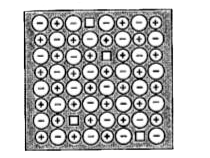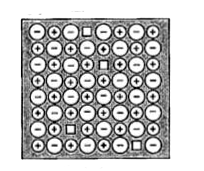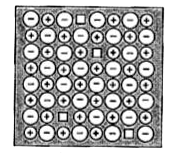Note: In the following questions a statement of assertion followed by a statement of reason is given. Choose the correct answer out of the following choices.
Assertion : Lassaigne's test is not shown by diazonium salts.
Reason : Diazonium salts lose N2 on heating much before than they have a chance to react with fused sodium.
The correct Answer is:a
To solve the assertion and reason question, we will analyze both the assertion and the reason step by step.
Step 1: Understand the Assertion
The assertion states: "Lassaigne's test is not shown by diazonium salts."
Explanation: Lassaigne's test is a qualitative analysis method used to detect the presence of certain elements (like nitrogen, sulfur, and halogens) in organic compounds. However, diazonium salts do not give a positive result in this test.
Step 2: Understand the Reason
The reason states: "Diazonium salts lose N2 on heating much before they have a chance to react with fused sodium."
Explanation: When diazonium salts are heated, they decompose readily to release nitrogen gas (N2). This decomposition occurs quickly, preventing the diazonium salts from reacting with the sodium in Lassaigne's test. Thus, the nitrogen that would be detected in the test is lost as gas before the test can be conducted.
Step 3: Conclusion
Both the assertion and the reason are correct. The assertion is true because diazonium salts do not show Lassaigne's test due to their tendency to lose nitrogen gas upon heating. The reason is also true, as it accurately explains why diazonium salts do not participate in Lassaigne's test.
Final Answer
Both the assertion and reason are true statements, and the reason is the correct explanation for the assertion.
---
The assertion states: "Lassaigne's test is not shown by diazonium salts."
The reason states: "Diazonium salts lose N2 on heating much before they have a chance to react with fused sodium."
Both the assertion and the reason are correct. The assertion is true because diazonium salts do not show Lassaigne's test due to their tendency to lose nitrogen gas upon heating. The reason is also true, as it accurately explains why diazonium salts do not participate in Lassaigne's test.
Both the assertion and reason are true statements, and the reason is the correct explanation for the assertion.
Topper's Solved these Questions
- ORGANIC CHEMISTRY: BASIC PRINCIPLES AND TECHNIQUESBOOK - MODERN PUBLICATIONCHAPTER - ORGANIC CHEMISTRY: BASIC PRINCIPLES AND TECHNIQUESEXERCISE - Revision ( Objective Questions ) Very Short Answer Questions
40 Videos
- ORGANIC CHEMISTRY: BASIC PRINCIPLES AND TECHNIQUESBOOK - MODERN PUBLICATIONCHAPTER - ORGANIC CHEMISTRY: BASIC PRINCIPLES AND TECHNIQUESEXERCISE - Revision ( Objective Questions ) Short Answer Questions (Carrying 2 or 3 marks)
56 Videos
- ORGANIC CHEMISTRY: BASIC PRINCIPLES AND TECHNIQUESBOOK - MODERN PUBLICATIONCHAPTER - ORGANIC CHEMISTRY: BASIC PRINCIPLES AND TECHNIQUESEXERCISE - Revision ( Objective Questions ) Fill in the Blanks Questions
10 Videos
- MOCK TEST-2BOOK - MODERN PUBLICATIONCHAPTER - MOCK TEST-2EXERCISE - SECTION D
1 Videos
- REDOX REACTIONS BOOK - MODERN PUBLICATIONCHAPTER - REDOX REACTIONS EXERCISE - COMPETITION FILE (Objective Questions) (C. MULTIPLE CHOICE QUESTIONS)
9 Videos
Similar Questions
Note: In the following questions a statement of assertion followed by a statement of reason is given. Choose the correct answer out of the following choices.
Assertion : Alkanes having more than three carbon atoms exhibit chain isomerism.
Reason : All carbon atoms in alkanes are sp3 hybridized.
View SolutionNote: In the following questions a statement of assertion followed by a statement of reason is given. Choose the correct answer out of the following choices.
Assertion : (CH3)3C+ is more stable than (CH3)2CH+ ion.
Reason : (CH3)3C+ has trigonal planar structure.
View Solution
Knowledge Check
Note: In the following questions a statement of assertion followed by a statement of reason is given. Choose the correct answer out of the following choices.
Assertion : Lassaigne's test is not shown by diazonium salts.
Reason : Diazonium salts lose N2 on heating much before than they have a chance to react with fused sodium.AIf both assertion and Reason are true, and reason is the true explanation of the assertion.BIf both assertion and reason are true, but reason is not the true explanation of the assertion.CIf assertion is true, but reason is falseDIf both assertion and reason are falseUse of assertion is followed by a statement of reason . Mark the correct choice as
AIf both assertion and reason are true and reasonBIf both assertion and reason are ture but reason is not the correct explanation of assertion.CIf assertion is true but reason is falseDIf both assertion and reason are false.
In these questions, a statement of Assertion followed by a statement of Reason is given. Choose the correct answer out of the following choices.
Assertion (A): LiCl Crystal is pink.
Reason (R): Pink colour of LiCl crystal is due to excess Lithium.ABoth A and R are true and R is the correct explanation of ABBoth A and R are true but R is NOT the correct explanation of ACA is true but R is falseDA is false and R is True
Note: In the following questions a statement of assertion followed by a statement of reason is given. Choose the correct answer out of the following choices.
Assertion : In allene (C3H4) all carbon atoms are sp2 hybridised.
Reason : All the three carbon atoms are joined by double bond.
View SolutionNote: In the following questions a statement of assertion followed by a statement of reason is given. Choose the correct answer out of the following choices.
Assertion : All the C−C bond lengths in benzene are equivalent.
Reason : The resonance energy of benzene is about 150.6 kJ mol−1.
View Solution
In these questions, a statement of Assertion followed by a statement of Reason is given. Choose the correct answer out of the following choices.
Assertion (A): The diagram shows Schottky defect.
Reason (R): Schottky defect occurs in ionic solids.
View Solution
In these questions, a statement of Assertion followed by a statement of Reason is given. Choose the correct answer out of the following choices.
Assertion (A): The crystal lattice density increases due to the defect shown in the diagram.
Reason (R): Tetrahedral voids are surrounded by 4 constituent particles.
View Solution
In these questions, a statement of Assertion followed by a statement of Reason is given. Choose the correct answer out of the following choices.
Assertion (A): AgCl shows Frenkel defect while NaCl does not.
Reason (R): Frenkel defect is shown when anionic vacancies are occupied by unpaired electrons.
View Solution
